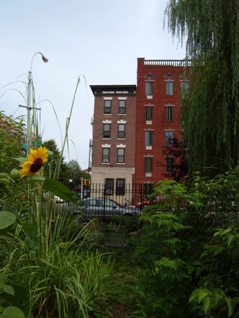Partnerships for Environmental Public Health (PEPH)
Academic Partner:
Cornell University
Murray B. McBride, Ph.D
Community Partners:
New York State Health Department
GreenThumb
Cornell University Cooperative Extension - New York City

A community garden in Brooklyn that had been a vacant lot with illegal dumping. Top soil was brought in to cover the contaminated site.
(Photo courtesy of Urban Environment Program, Cornell University Cooperative Extension-New York City)
Project Description
Researchers at Cornell University collaborated with the New York City office of the Cornell University Cooperative Extension, the New York State Department of Health, and the community-based organization GreenThumb to improve public health by increasing awareness about both the benefits and risks of urban gardening.
The need for affordable, healthy foods, including organic and locally grown produce, has increased public interest in home, school, and community gardens. While urban gardens provide numerous public health and quality-of-life benefits, the extent of soil contamination in many communities throughout the United States may represent a significant route of contaminant exposure to gardeners. Inner-city communities are often exposed to higher levels of some contaminants (e.g., lead) as compared to other areas. In urban soils, some contaminants are commonly present due to factors such as the historic use of lead paint, leaded gasoline, lumber treated with chromated copper arsenate, and the application of lead-arsenate pesticides in some areas. Many inner-city gardens are located in communities of lower economic status, often on vacant lots and abandoned properties where the extent of soil contamination is uncertain.
The project partners:
- Conducted a soil survey that revealed that metal levels in New York City community garden soils were similar to those in soils in other large cities, with 70 percent of gardens having at least one sample exceeding a health-based guidance value.
- Found that lead was below guidance values established by the U.S. Food and Drug Administration (FDA) in virtually all fruits, but 47 percent of root crops and 9 percent of leafy greens exceeded guidance values, and over half the vegetables exceeded the 95th percentile of market-basket concentrations.
- Communicated and interpreted study results for gardeners through letters, meetings, gardening workshops, videoconferences, and conference calls.
- Conducted an exposure assessment that showed that 10 percent of gardeners and 40 percent of visiting children had the potential of exceeding FDA provisional tolerable intake for lead, primarily due to vegetable consumption for gardeners and ingestion of soil and associated dust for children.
- Based on the exposure assessment, the researchers developed and widely distributed extension/outreach programming to help gardeners and stakeholder groups reduce risk, partially remediated the most contaminated gardens with clean soil, identified future research needs, and initiated a dialog regarding development of health protective policy for community gardens.
This partnership aimed to reduce exposures of urban gardeners to soil contaminants by empowering communities to implement effective, community-based exposure mitigation strategies.
Selected Publications:
- Spliethoff HM, Mitchell RG, Shayler H, Marquez-Bravo LG, Russell-Anelli J, Ferenz G, McBride M. 2016. Estimated lead (Pb) exposures for a population of urban community gardeners. Environ Geochem Health 38(4):955-971. [Abstract Spliethoff HM, Mitchell RG, Shayler H, Marquez-Bravo LG, Russell-Anelli J, Ferenz G, McBride M. 2016. Estimated lead (Pb) exposures for a population of urban community gardeners. Environ Geochem Health 38(4):955-971.]
- Marquez-Bravo LG, Briggs D, Shayler H, McBride M, Lopp D, Stone E, Ferenz G, Bogdan KG, Mitchell RG, Spliethoff HM. 2016. Concentrations of polycyclic aromatic hydrocarbons in New York City community garden soils: Potential sources and influential factors. Environ Toxicol Chem 35(2):357-367. [Abstract Marquez-Bravo LG, Briggs D, Shayler H, McBride M, Lopp D, Stone E, Ferenz G, Bogdan KG, Mitchell RG, Spliethoff HM. 2016. Concentrations of polycyclic aromatic hydrocarbons in New York City community garden soils: Potential sources and influential factors. Environ Toxicol Chem 35(2):357-367.]
- Mitchell RG, Spliethoff HM, Ribaudo LN, Lopp DM, Shayler HA, Marquez-Bravo LG, Lambert VT, Ferenz GS, Russell-Anelli JM, Stone EB, McBride MB. 2014. Lead (Pb) and other metals in New York City community garden soils: factors influencing contaminant distributions. Environ Pollut 187:162-169. [Abstract Mitchell RG, Spliethoff HM, Ribaudo LN, Lopp DM, Shayler HA, Marquez-Bravo LG, Lambert VT, Ferenz GS, Russell-Anelli JM, Stone EB, McBride MB. 2014. Lead (Pb) and other metals in New York City community garden soils: factors influencing contaminant distributions. Environ Pollut 187:162-169.]
- McBride MB, Shayler HA, Spliethoff HM, Mitchell RG, Marquez-Bravo LG, Ferenz GS, Russell-Anelli JM, Casey L, Bachman S. 2014. Concentrations of lead, cadmium and barium in urban garden-grown vegetables: the impact of soil variables. Environ Pollut 194:254-261. [Abstract McBride MB, Shayler HA, Spliethoff HM, Mitchell RG, Marquez-Bravo LG, Ferenz GS, Russell-Anelli JM, Casey L, Bachman S. 2014. Concentrations of lead, cadmium and barium in urban garden-grown vegetables: the impact of soil variables. Environ Pollut 194:254-261.]
- McBride MB, Simon T, Tam G, Wharton S. 2013. Lead and arsenic uptake by leafy vegetables grown on contaminated soils: effects of mineral and organic amendments. Water Air Soil Pollut 224(1):pii:1378. [Abstract McBride MB, Simon T, Tam G, Wharton S. 2013. Lead and arsenic uptake by leafy vegetables grown on contaminated soils: effects of mineral and organic amendments. Water Air Soil Pollut 224(1):pii:1378.]


